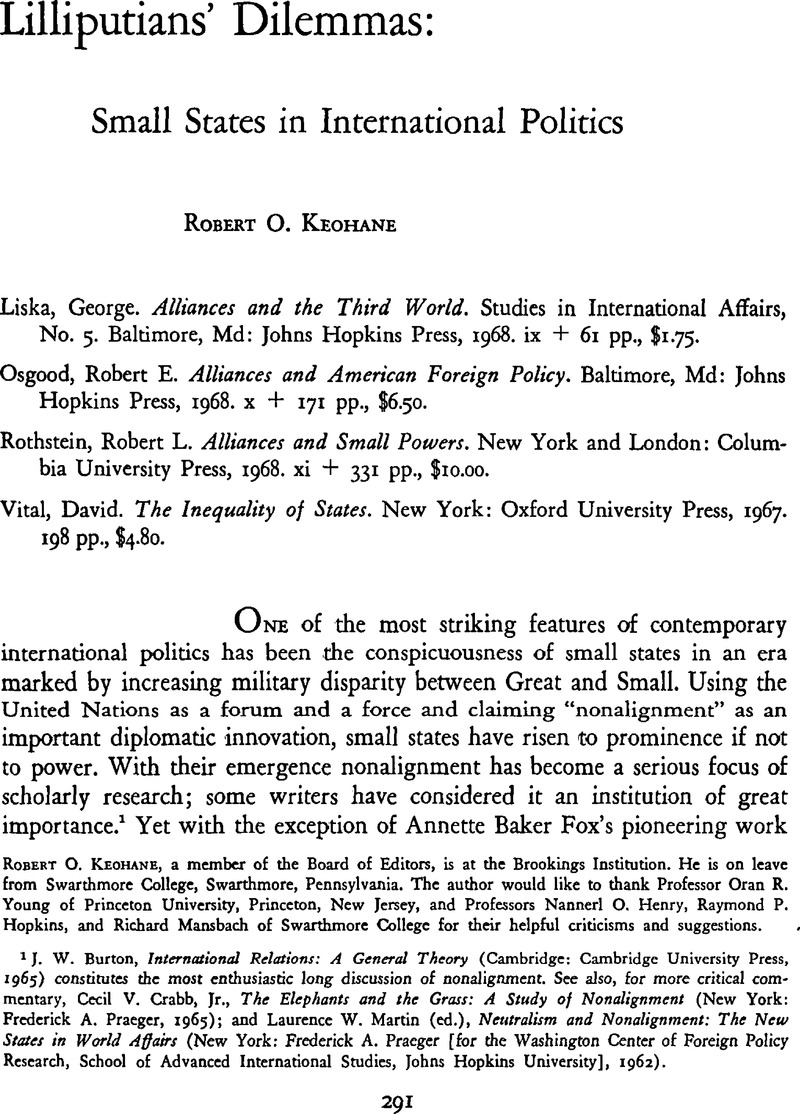Published online by Cambridge University Press: 22 May 2009

1 Burton, J. W., International Relations: A General Theory (Cambridge: Cambridge University Press, 1965)Google Scholar constitutes the most enthusiastic long discussion of nonalignment. See also, for more critical commentary, Crabb, Cecil V. Jr, The Elephants and the Grass: A Study of Nonalignment (New York: Frederick A. Praeger, 1965)Google Scholar; and Martin, Laurence W. (ed.), Neutralism and Nonalignment: The New States in World Affairs (New York: Frederick A. Praeger [for the Washington Center of Foreign Policy Research, School of Advanced International Studies, Johns Hopkins University], 1962)Google Scholar.
2 Fox, Annette Baker, The Power of Small States: Diplomacy in World War II (Chicago: Chicago University Press, 1959)Google Scholar.
3 For a very critical view of nonalignment as a policy see Low-Beer, Francis, “The Concept of Neutralism,” American Political Science Review, 06 1964 (Vol. 58, No. 2), pp. 383–391CrossRefGoogle Scholar.
4 Consider, for example, the discussions and resolutions on “nonintervention” at the twentieth session of the General Assembly. Claude, Inis L. has commented on one aspect of this phenomenon in his discussion of “collective legitimization.” (“Collective Lcgitimization as a Political Function of the United Nations,” International Organization, Summer 1966 [Vol. 20, No. 3], pp. 367–379CrossRefGoogle Scholar.) The discussions and resolutions on “nonintervention” at the twentieth session of the General Assembly provide further examples of collective dogma creation.
5 Olson, Mancur Jr, The Logic of Collective Action: Public Goods and the Theory of Groups (Cambridge, Mass: Harvard University Press, 1965)Google Scholar.
6 Olson, Mancur Jr, and Zeckhauser, Richard, “An Economic Theory of Alliances,” Review of Economics and Statistics, 08 1966 (Vol. 48, No. 3), pp. 266–279CrossRefGoogle Scholar.
7 See Osgood, pp. 21–22; Liska, pp. 23–25.
8 Great Powers need not pursue any of these policies unilaterally. International organizations can often be used in the service of any of the three alternatives or, as in peacekeeping operations, in an attempt to combine policies of involvement and withdrawal.
9 This sentence may be taken to imply skepticism that the comments on “even-handedness” by William Scranton, then President-elect Richard M. Nixon's foreign policy envoy, foreshadow significant policy changes.
10 These phrases are used by Rothstein, p. 49.
11 This emphasis on small-state influence on Great Powers' decisions may perhaps be explained by the fact that the author is currently working on a study of that problem and by authors' natural tendencies to assume the importance of questions that interest them.
12 For an excellent example of “giant study” see Hoffmann, Stanley, Gulliver's Troubles, Or the Setting of American Foreign Policy (New York: McGraw-Hill [for the Council on Foreign Relations], 1968Google Scholar) which also provided inspiration for the title of this essay.